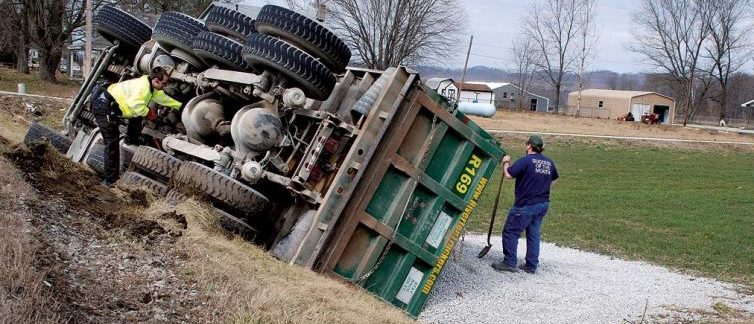
Dump truck tip-overs are occurring at an increasing frequency, often resulting in drivers and surrounding workers being injured or killed.
The reason for the increase is that end-dump-truck bodies and semi-trailer dumping rigs are being built longer than ever before. For the most part, tip-overs are more often associated with semi-trailer rigs than with straight dump trucks, but both are susceptible to tipping over.
- Truck stability
- Poor hazard controls
- Poor maintenance
- Improper loading
- Improper dumping
Stability
The time when the dump truck is at its most unstable is when the box is in the raised position. When the center of gravity of the box and load is not roughly between the frame rails of the unit, there is a risk of tip-over.
- The truck is on an unlevel surface when dumping.
- There is too much material in the upper portion of the raised box.
- Material gets stuck in the top portion of the box, or on one side of the top portion.
- The rear wheels settle unevenly as the load slides out of the box.
- Heavy winds can tip trucks with raised boxes over, especially if the box is of the longer variety.
Hazard control
You should also avoid using semi-trailer dump trucks on rough grading, or on uneven or loosely compacted surfaces.
If you are hauling material on these types of surfaces, you should opt for a straight dump truck instead, which has less chance of slippage since it is not pulling a trailer.
If the truck is hauling aggregates that will be spread for road construction, belly-dump semi-trailers are a better and safer choice than end-dump semi-trailers.
We understand that you may not always have a choice of dump vehicles, but you should try to use trucks that are appropriate for the conditions.
One other consideration: In cold weather environments, you should consider heated boxes. Otherwise, there is a chance the materials may freeze in the box and stick during dumping.
Maintenance
Preventive maintenance can also reduce the chances of tip-overs.
- Check tire pressures before the start of each work day. The pressure should be the same on both sides of the vehicle, and according to the manufacturer’s recommendations. Uneven pressure can cause instability.
- Examine and lubricate pins and bushings regularly.
- Inspect suspension systems under the box to ensure that they work properly and provide even suspension. If the suspension system is worn or weak, replace it immediately.
- Inspect hoist cylinders regularly. If worn, replace them with cylinders of the same specification (no smaller cylinders and none that are rated at lower operating pressure).
- Make sure that repairs to boxes leave the bottom and sides clear and unrestricted. Rough patchwork repairs near the top of the box can catch and hold sticky materials.
Loading
Boxes should be loaded front to back, and the load must be less than allowable gross weight and axle weight limitations set by the U.S. Department of Transportation or your state’s DOT.
Don’t pile too much material at the top end of the box, as it can impede the flow. Consider spreading it out more or reducing the load.
You may also want to install box liners, which can help materials flow better during dumping.
Dumping
- Operators should be trained to recognize unsafe dumping areas like soft surfaces or surfaces that are not properly compacted. Before dumping, the truck should be on a reasonably level surface.
- Prior to dumping, operators should ensure that the tailgate is unlocked.
- Before spreading material by dumping it from a moving truck, make sure that the entire length of travel is reasonably level.
- Trucks should not dump when they are parked side by side with another vehicle, as this can risk injury to the operator of the adjacent vehicle.
- Dumping operations should not be too close together, which increases the risk of injury.
- Other personnel must be warned prior to the dumping operation to stay clear.
- Workers should not congregate in areas where dumping is under way.